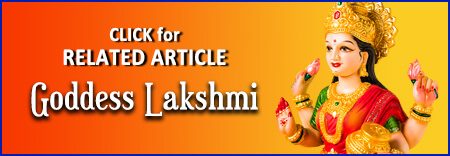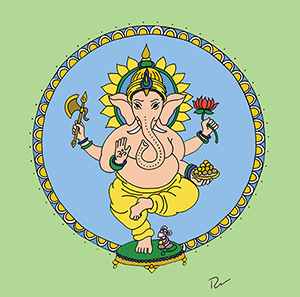
Yantra Symbol Meaning
Yantras can represent a specific deity, an aspect of God or a single sound. Yantras are mystical diagrams associated with particular thoughts and rituals. Yantras can be combined with mantras to accompany chanting and meditation.
Storing Energy in a Yantra
In some schools of thinking, the yantra is a dwelling place for a deity. A yantra can also store energy to provide protection to a person or geographical location. The symbols of the chakras themselves are a form of yantra.
Table of Contents
Share this page with a friend!
Four Aspects of Yantra Meaning
There are four main aspects to two-dimensional yantras:
- symbols used
- drawing surface
- drawing materials
- process used to energize
In addition, yantras are used (often on copper plates) on the walls outside of temples. They are also used on personal altars in homes. The geometry of a yantra is said to connect the human form with cosmic forces.
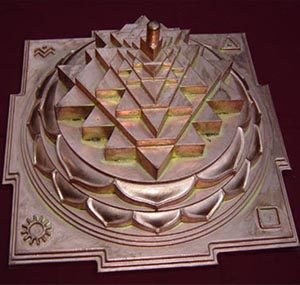
Color Meaning in Yantras
Yantras may be black and white, carved on wood, engraved on stone or painted. Painted yantras utilize symbolic colors. Although there are traditional colors for each yantra, the colors can be decided in relation to the goal and purpose of the yantra. If the goal is abundance or auspicious outcomes in a practical sense, the yantra is generally red. If the purpose is to reconcile or appease, the color is often yellow.
Black: Black in a yantra symbolizes inertia, can also mean the withdrawing of the world back into the Goddess; a sum of all colors.
Brown, orange-brown or yellow-brown: Brown or tawny colors in a yantra mean dissolution and destruction.
Gold: Gold in a yantra means transcendence, abundance and good fortune; wealth, light and spiritual bliss.
Red: Red in a yantra means activation, flaming fire; red is associated with the solar plexus and the breath of life; red is the color of preservation.
White: White in a yantra represents purity, traditionally created from finely ground rice; associated with water; the color of liberation.
Yellow: Yellow in a yantra is associated with the earth element as well as the sun; also associated with the lightning bolt of Indra, the sky god; yellow conveys the power to initiate action.

Circles and Yantra Meaning
The circle is a physical manifestation that is a counterpart to the spiritual realms. A circle is a primordial form that cannot be further reduced. A circle at the smallest size becomes a point or the bindu, as discussed above.
Circle Symbolism in Yantras
The circle symbolizes infinite space (the element akasha) and expansiveness. The circle also represents the cycles of nature at all levels from the atom to astronomy. The central quest of spirituality is to experience the oneness of these realms.
Click to read our article on Sacred Flowers around the world!
Lotus and Yantra Meaning
The lotus symbolizes purity, enlightenment and transcendence. In a yantra, the lotus is usually viewed from the top, with the petals extending out on the rim of a circle. The lotus illustrates the unfolding of the divine essence within. The lotus is like the navel of creation. In fact, the lotus is sometimes depicted as springing from the navel of Vishnu and giving birth to Brahma, two of the gods in the Hindu trinity.
Lotus and the Heart Chakra
The lotus is also a symbol of the heart, especially the inner or secret chamber of the heart. This is sometimes called Brahma’s cave or the city of Brahma in the East or the inner castle in the West. This is the core of being that remains untouched by everyday living.
Triangles and Yantra Meaning
The downward triangle is a symbol of the divine feminine, often associated specifically with the goddess Kali or Parvati. The downward triangle is a depiction of the water element. An upward triangle represents the masculine energy and the element of fire. The upward triangle is specifically associated with Shiva.
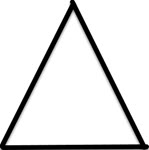
Symbolism of Interlocking Triangles
Numerous triangles can be interlocked in the center of a yantra. Each of these triangle represents different planes of existence. The root chakra symbol includes a downward triangle indicating the descent of spirit into matter.
Watch nearly 400 videos on the Vocal Medicine Channel!
Hexagon and Yantra Meaning
The hexagon or hexagram symbolizes the union of male and female forces in intertwined triangles. This is the fusion of polarities that remains in perfect balance. Since the two larger overlapping triangles create six smaller triangles, the numerical equivalent of this symbol is a six.
Meaning of a Star-Pentagram
A star-pentagram can also be created. This is associated with the number five. This form is connected to Shiva in his five major aspects: the conqueror of death, the embodiment of knowledge, the source or being of life, the master of lust, sexuality and the lord of the elements.

Squares and Yantra Meaning
The square represents the four cardinal directions in yantras. A square symbolizes the foundation or base of the material world. Most yantras have a square as their fundamental form. The numerical equivalent, of course, is four. The square connects to the earth element in the Vedic tradition (earth, water, fire, space, air).
Gate Symbolism in Yantras
On each side of the yantra are gates that open up to invite the viewer into the center of the yantra. These portals also represent a passage between the heaven world and the plane of material existence. They also symbolize the opening between the inner and outer realms of the individual. The gates protect the center from disintegrating or negative forces.
Learn more about One Word Mantras!
Sanskrit Characters in Yantras
Some yantras have numbers and letters or words written on them. These yantras tend to be square rather than circular. The words may form a mantra related to the yantra. For numbers, the numbers have symbolic meaning for good fortune, protection or other purposes.
Mantras Written in Yantras
The Hanuman Yantra is an example of a yantra with an entire mantra written in the center. Not only does the mantra have specific meaning, but each of the sound-s\syllables have a different impact on the environment and the viewer. See the information below or refer to the in-depth article on the Hanuman Yantra.
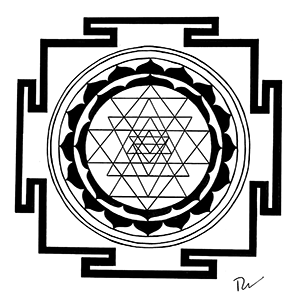
Specific Yantra Meanings
Sri Yantra
The Sri Yantra is the most powerful and well-known of all of the yantra symbols. This is the yantra of wealth and supreme energy. The Sri Yantra is based on nine interlocking tringles. There are four upward and five downward triangles, creating forty-three intersecting triangles.
Meaning of the Outer Square
The outer square established a stable foundation. There are four doorways or gates. These are viewed as thresholds into the outer world. The circle in the center brings focus to the mind of the viewer. The lotus petals represent creation and life force. See the following article for a full discussion of the meaning of every aspect of the this amazing symbol: Sri Yantra Meaning Comprehensive Guide.
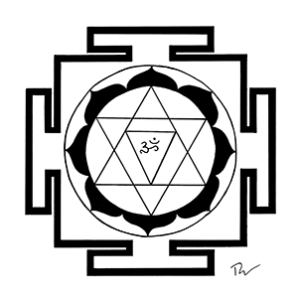
Gayatri Yantra Meaning
The Gayatri yantra symbol meaning includes multiple layers of spiritual significance. The Gayatri yantra symbol is a visual counterpart for a family of mantras known as the Gayatris. Central to the Gayatri yantra symbol meaning is the Sanskrit syllable OM. The form of the yantra is viewed as condensed or crystallized sound.
Form of Gayatri Poetry
Gayatri is a Vedic poetic meter of twenty-four syllables or any hymn composed in this meter. Hence, there exists a whole family of Gayatri Mantras, all of which serve as meditative aids. Estimates are that there are over 400 Gayatri poems in the Hindu tradition.
Geometry Used in the Gayatri Yantra
One level of meaning is the geometry used to create the Gayatri yantra. Yantras usually have a central form radiating out from the center. The intent of a yantra is to focus the mind as well as to serve as a repository of spiritual energy. For this reason, yantras can be used for protection. Learn more details in our article on the Gayatri Yantra.
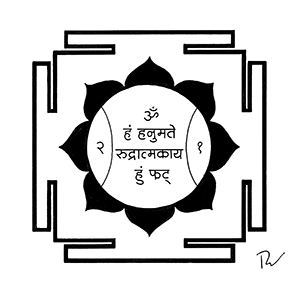
Hanuman Yantra Meaning
The Hanuman yantra is a symbolic representation of the Hindu monkey-god and his primary mantras. He is the hero of epics and stories in Hinduism, Jainism and Buddhism. Hanuman is the ardent devotee of Lord Rama. He is a central figure in the epic Hindu poem Ramayana.
Meaning of Hanuman’s Name
Some interpretations of the name “Hanuman” are the Sanskrit words “han” meaning killed or destroyed and “maana” meaning pride. With this interpretation, Hanuman would mean “one whose pride was destroyed.”
The mantra associated with the Hanuman yantra is “OM HUM Hanumate Rudratmakaya Hoom Phat.” Hanuman is known for fierce loyalty and unfailing energy. Hanuman is often appealed to for solutions in seemingly impossible circumstances. Learn more in our article on the Hanuman Yantra.
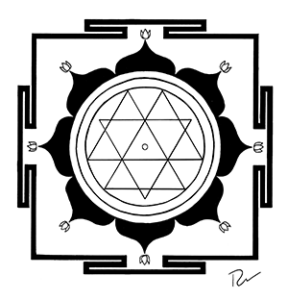
Durga Yantra Meaning
The Durga Yantra is a protection yantra, based on the idea that it is better to protect yourself and thus divert misfortune whenever possible rather than be forced to do battle. Durga is a warrioress with indomitable strength. Like Kali, she will help you to let go of anything that is no longer serving you. In addition, she can serve as a shield on many levels as you move through the world.
Qualities of the Goddess Durga
Durga cultivates a unique combination of fearlessness, courage and love. The many upward pointing triangles in the yantra emphasize spiritual freedom. The downward pointing triangles represent the descent of spirit into matter. The upward pointing triangles represent the ascent of matter into spirit. Durga’s colors are white, silver, gold, saffron, orange and red.
Watch nearly 400 videos on the Vocal Medicine Channel!
Durga’s Shield Mantra
The mantra associated with the Durga Yantra is “Om Aim Hrim Klim Chamundaye Viche.” The word “Chamundaye” is a reference to Durga and the slayer of Chamunda, an evil demon.“Viche” means a “shield” and indicates Durga’s role in protecting her own. Durga has the role of destruction for the sake of universal harmony.
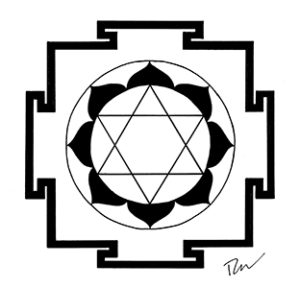
Lakshmi Yantra Meaning
The Lakshmi Yantra is dedicated to the Hindu goddess of wealth and abundance. She is also connected to the solar plexus chakra. The geometric forms creating Lakshmi’s Yantra include interlocking triangles, the lotus flower, the circle, square and the gates in each cardinal direction.
The interlocking triangles are the balance of the masculine and feminine. The consort of Lakshmi is Vishnu, an incarnation of Krishna. There are eight petals in the lotus flower that surrounds the interlocking triangles. The eight petals represent speech, transaction, departure, transcendence, bliss, absence, giving and neglect.
Birth of the Goddess Lakshmi
Lakshmi is said to have been born when the gods and demons joined together to stir the primordial ocean. Without Lakshmi, the world is said to become dark and infertile. Lakshmi is often associated with white elephants, a symbol of good luck and fortune. She is depicted seated on a lotus, just as the lotus is a central feature of her yantra.
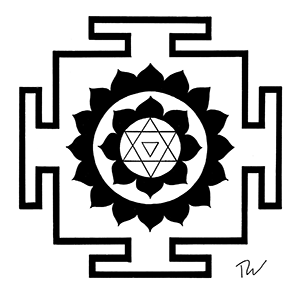
Baglamuhki Yantra Meaning
The Baglamuhki Yantra is a yantra of protection on personal and professional levels. Baglamuhki is a goddess of strength and power, particularly with the power to neutralize gossip and negative speech. For this reason, she is a goddess of protection.
Meaning of the Inner Lotus Flower
The inner lotus flower with eight petals is surrounded by a larger lotus ring with 16 petals. Like many other yantras, the interlocking triangles in the center establish the balance of yin and yang or masculine and feminine. These petals in the larger ring represent the 16 sacred vowels.
Sacred Vowels and Associated Lotus Petals
The sacred vowels correspond to the 10 senses of perception, the five elements and the mind. The yantra or symbol for the throat chakra also has the same 16 petals. Learn more about the Chakra Symbols. The gates on the perimeter of the yantra represent the four cardinal directions. The seeker can enter the yantra symbolically through each of these gates.
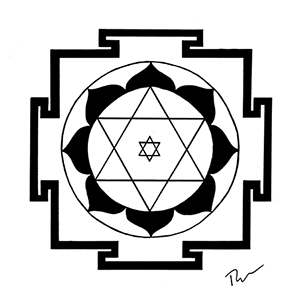
Ganesha Yantra Meaning
The Ganesha Yantra utilizes many of the same basic shapes as the Sri Yantra. The six-pointed star is a simplified version of the nine interlocking triangles of the Sri Yantra. The interlocking stars in Ganeha’s yantra symbolizes balance and harmony. Another six-pointed star takes the place of the bindu in the center of the yantra.
Ganesha’s Mantra
The mantra associated with this symbol is “Om Gam Ganapataye Namaha” and means “Salutations to the remover of obstacles!” Ganesha’s seed syllable is GAM (pronounced “gum”). This is a sound that conveys his fundamental vibration. Ganesha is the master of both inner and outer journeys. Ganesha is known for knowledge, patience, preparation and grounding.
Metaphor of the Elephant
The sheer weight of an elephant is a wonderful metaphor for the earth-based energy necessary for successful projects and endeavors. For example, the energy of Ganesha can form a strong foundation for a new business. The energy of Ganesha can also help to clear away the uncertainty and self-doubt that may hinder a new venture.
The Birth of Ganesha
Tales of Ganesha’s origins differ widely. In some stories, Parvati created him from clay. Another legend says that Parvati created him from the soap suds in her bath. Another myth claims that Shiva’s laughter created him. In yet another tale, Ganesha simply appeared mysteriously and was found by Shiva and Parvati. Ganesha is the patron of the arts, crafts and sculpture.
More Ganesha Symbolism
When colored, the Ganesha Yantra usually includes deep, rich earth colors like forest green, golden yellow, primary red and orange. The four gates around the Ganesha yantra represent the four directions. The circle around the lotus is a symbol of expansiveness, the cycles of nature and the infinite universe encompassing all. Learn more about Ganesha in the article Ganesha Mantra.
Learn all about the Ganesha Yantra in the article Ganesha Yantra Power and Meaning.
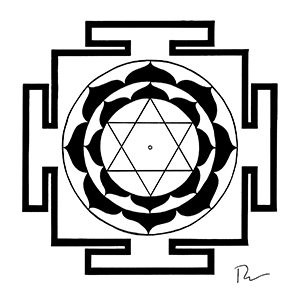
The Surya Yantra Meaning
The Surya Yantra is sometimes called the Radiance Yantra. The twelve outer petals are known as the celestial beams of the sun. They are symbolic of the twelve months of the year and the twelve astrological signs. The sun is the regal master of the entire solar system and the visible universe.
Circle Meaning and the Sun
The circle is repeated three times in this yantra, representing the cycles of nature guided by the sun and the expansiveness of the universe. The mantra associated with the Surya Yantra is “Om Hram Hrim Hraum Saha Suryaya Namaha.” As the god of the sun, Surya brings illumination, healing and spiritual magnetism.
Yantras and the Viewer’s Intentions
The yantra and the mantra are both tools for guiding the thoughts and feelings in healthy patterns, but the viewer’s intention is paramount. The sun is seen as the ultimate healer for all conditions, especially the eyes. When colored, the Surya Yantra is decorated with flaming red, orange, silver and gold.
Celebrating the Light of the Sun
Focusing on the Surya Yantra can be particularly appropriate for extending yourself into new social situations, travel or undertaking adventures in life. Surya rides across the sky in a chariot pulling the sun. His charioteer Aruna manages the seven horses, symbolic of the seven chakras. Surya is a celebration of light and illumination in yourself and others.
Watch nearly 400 videos on the Vocal Medicine Channel!
Names for the Sun God
There are twelve names for Surya, each with their own meaning:
- Mitraya: the friend of all
- Ravaye: praised by all
- Suryaya: the guide of all
- Bhanave: the besstower of beauty
- Khagaya: stimulator of the sense
- Pushne: the nourisher of all
- Hiranyagarbhaya: the creator
- Marichaye: destroyer of disease
- Adityaya: the inspirer
- Arkaya: the radiant one
- Bhaskaraya: the illuminator
Author Kathleen Karlsen
Kathleen Karlsen is a musician, artist, writer and speaker. She is the author of two books (Flower Symbols and Vocal Medicine) and over 200 articles. Kathleen, her husband Andrew, and their five children live in Bozeman, Montana. More about Kathleen Karlsen.


